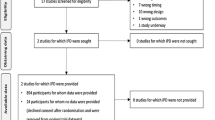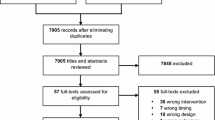Abstract
Purpose
In shock, hypotension may contribute to inadequate oxygen delivery, organ failure and death. We conducted the Optimal Vasopressor Titration (OVATION) pilot trial to inform the design of a larger trial examining the effect of lower versus higher mean arterial pressure (MAP) targets for vasopressor therapy in shock.
Methods
We randomly assigned critically ill patients who were presumed to suffer from vasodilatory shock regardless of admission diagnosis to a lower (60–65 mmHg) versus a higher (75–80 mmHg) MAP target. The primary objective was to measure the separation in MAP between groups. We also recorded days with protocol deviations, enrolment rate, cardiac arrhythmias and mortality for prespecified subgroups.
Results
A total of 118 patients were enrolled from 11 centres (2.3 patients/site/month of screening). The between-group separation in MAP was 9 mmHg (95 % CI 7–11). In the lower and higher MAP groups, we observed deviations on 12 versus 8 % of all days on vasopressors (p = 0.059). Risks of cardiac arrhythmias (20 versus 36 %, p = 0.07) and hospital mortality (30 versus 33 %, p = 0.84) were not different between lower and higher MAP arms. Among patients aged 75 years or older, a lower MAP target was associated with reduced hospital mortality (13 versus 60 %, p = 0.03) but not in younger patients.
Conclusions
This pilot study supports the feasibility of a large trial comparing lower versus higher MAP targets for shock. Further research may help delineate the reasons for vasopressor dosing in excess of prescribed targets and how individual patient characteristics modify the response to vasopressor therapy.



Similar content being viewed by others
References
Angus DC, van der Poll T (2013) Severe sepsis and septic shock. N Engl J Med 369:2063. doi:10.1056/NEJMc1312359
Vincent JL, De Backer D (2013) Circulatory shock. N Engl J Med 369:1726–1734. doi:10.1056/NEJMra1208943
Bellomo R, Kellum JA, Wisniewski SR et al (1999) Effects of norepinephrine on the renal vasculature in normal and endotoxemic dogs. Am J Respir Crit Care Med 159:1186–1192. doi:10.1164/ajrccm.159.4.9802055
Dunser MW, Mayr AJ, Tur A et al (2003) Ischemic skin lesions as a complication of continuous vasopressin infusion in catecholamine-resistant vasodilatory shock: incidence and risk factors. Crit Care Med 31:1394–1398. doi:10.1097/01.CCM.0000059722.94182.79
Schmittinger CA, Torgersen C, Luckner G et al (2012) Adverse cardiac events during catecholamine vasopressor therapy: a prospective observational study. Intensive Care Med 38:950–958. doi:10.1007/s00134-012-2531-2
Weil MH, Tang W (2009) Challenging the rationale of routine vasopressor therapy for management of hypotension. Crit Care 13:179. doi:10.1186/cc7976
Dellinger RP, Levy MM, Rhodes A et al (2013) Surviving Sepsis Campaign: international guidelines for management of severe sepsis and septic shock: 2012. Crit Care Med 41:580–637. doi:10.1097/CCM.0b013e31827e83af
Mouncey PR, Osborn TM, Power GS et al (2015) Trial of early, goal-directed resuscitation for septic shock. N Engl J Med 372:1301–1311. doi:10.1056/NEJMoa1500896
Peake SL, Delaney A, Bailey M et al (2014) Goal-directed resuscitation for patients with early septic shock. N Engl J Med 371:1496–1506. doi:10.1056/NEJMoa1404380
Yealy DM, Kellum JA, Huang DT et al (2014) A randomized trial of protocol-based care for early septic shock. N Engl J Med 370:1683–1693. doi:10.1056/NEJMoa1401602
Asfar P, Meziani F, Hamel JF et al (2014) High versus low blood-pressure target in patients with septic shock. N Engl J Med. doi:10.1056/NEJMoa1312173
De Backer D, Aldecoa C, Njimi H et al (2012) Dopamine versus norepinephrine in the treatment of septic shock: a meta-analysis. Crit Care Med 40:725–730. doi:10.1097/CCM.0b013e31823778ee
De Backer D, Biston P, Devriendt J et al (2010) Comparison of dopamine and norepinephrine in the treatment of shock. N Engl J Med 362:779–789. doi:10.1056/NEJMoa0907118
Panwar R, Lanyon N, Davies AR et al (2013) Mean perfusion pressure deficit during the initial management of shock–an observational cohort study. J Crit Care 28:816–824. doi:10.1016/j.jcrc.2013.05.009
D’Aragon F, Belley-Cote EP, Meade MO et al (2015) Blood pressure targets for vasopressor therapy: a systematic review. Shock 43:530–539. doi:10.1097/SHK.0000000000000348
Heyland DK, Muscedere J, Drover J et al (2011) Persistent organ dysfunction plus death: a novel, composite outcome measure for critical care trials. Crit Care 15:R98. doi:10.1186/cc10110
Vincent JL, Moreno R, Takala J et al (1996) The SOFA (Sepsis-related Organ Failure Assessment) score to describe organ dysfunction/failure. On behalf of the Working Group on Sepsis-Related Problems of the European Society of Intensive Care Medicine. Intensive Care Med 22:707–710
Hinkle JL, McClaran J, Davies J et al (2010) Reliability and validity of the adult alpha functional independence measure instrument in England. J Neurosci Nurs 42:12–18
Brown SM, Lanspa MJ, Jones JP et al (2013) Survival after shock requiring high-dose vasopressor therapy. Chest 143:664–671. doi:10.1378/chest.12-1106
Acknowledgments
We would like to express our gratitude for the contribution and support of Janet Overvelde, Shawna Froese, Jesse Gadon, the Institute for Safer Medication Practices Canada, the Canadian Critical Care Society, the Canadian Society of Hospital Pharmacists, the Canadian Association of Emergency Physicians, the Canadian Association of Critical Care Nurses and the intensive care unit nurses and physicians who collaborated on this work. Dr. Tom Stelfox conducted the internal review of this manuscript for the Canadian Critical Care Trials Group. We are also indebted to Dr. Andreas Laupacis (Chair), Dr. Lauren Griffiths and Dr. Scott Halpern who constituted the Data Monitoring Committee for this trial. This study would not have been feasible without the outstanding participation of (in alphabetical order) Sarah-Judith Breton, Katia Cauchon, Paulina Farais, Susan Fleury, Brittany Giacomino, Marnie Jakab, Lisa Julien, Catherine Krause, Chantal Langevin, Heather Langlois, Nicole Marinoff, Andrea Matte, Tracy McArdle, Katie O'Brien, Rebecca Porteus, , Sumesh Shah, Samantha Taylor, and Irene Watpool.
Author information
Authors and Affiliations
Consortia
Corresponding author
Ethics declarations
Conflicts of interest
None reported.
Additional information
Take-home message: This pilot study supports the feasibility of a larger trial comparing MAP targets below those applied in the SEPSISPAM trial. Further research may help delineate the reasons for vasopressor dosing in excess of prescribed targets and how individual patient characteristics modify the response to vasopressor therapy.
Electronic supplementary material
Below is the link to the electronic supplementary material.
Rights and permissions
About this article
Cite this article
Lamontagne, F., Meade, M.O., Hébert, P.C. et al. Higher versus lower blood pressure targets for vasopressor therapy in shock: a multicentre pilot randomized controlled trial. Intensive Care Med 42, 542–550 (2016). https://doi.org/10.1007/s00134-016-4237-3
Received:
Accepted:
Published:
Issue Date:
DOI: https://doi.org/10.1007/s00134-016-4237-3




